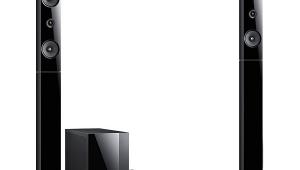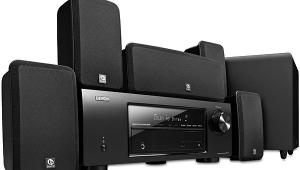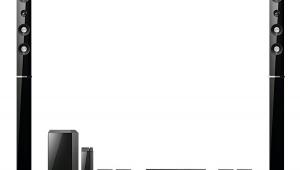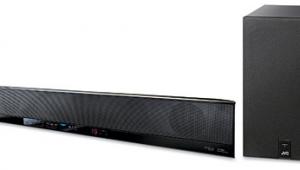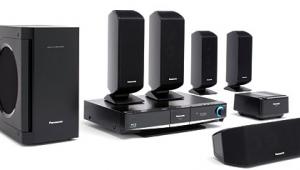JVC TH-F3 DVD Digital Theater System
4.1 Channels from 2.1 Speakers
Manufacturers of home theater gear work within a rigid framework. That makes it easy for consumers to recognize product categories—speaker systems, receivers, separates—and investigate the trade-offs between performance and price. But these product categories can also be staid and boring because they rarely investigate alternative system architectures. To shake things up a little, you have to look into compact systems, including entry-level ones like the JVC TH-F3 DVD Digital Theater System (to use the official nomenclature).

These HTIB systems may have seven, five, or two speakers, with or without the decimal point signifying a sub. For this one, the magic numbers are 4.1 channels and 2.1 speakers with energy-efficient switching amplification. The physical distribution of amplifier channels in compact systems often breaks the usual pattern of having the sub channel in the sub and the other channels in the receiver. In this system, all channels are in the receiver. The receiver may or may not have a built-in disc drive. In this case, it has a DVD drive.
To me, the TH-F3’s system architecture is an object of fascination. It includes only two speakers and a sub. But each speaker supports both front and surround channels within a single enclosure, so each channel gets its own full-range driver. I love this kind of thing. It gets me out of my home theater rut. Why should Home Theater readers take an alternate architecture seriously? Perhaps because you’d like something smaller scaled for a secondary system. You can also do more with less and save the conventional big guns for the family room or the dedicated basement home theater.

Fun with Anisotropy
Like the other components in this system, the DVD-receiver is not sold separately. It exists solely as part of the TH-F3. With a footprint about the size of a cable box, it says hello with a bold vertical LED stripe that separates the DVD drive at left from two columns of controls at right. JVC slightly differentiated the controls by shape—one column is square black buttons, the other is horizontal silver slivers. The legends are not bold enough in either case. Since the brightness of the LED tends to bias your eye, it makes it hard to read the labels that unlock the secrets of the buttons. The control arrangement is a little frustrating. For instance, the front-panel controls you’ll likely use when you start a disc are Eject and Play. Why is the Eject key at the bottom of the column of tiny square buttons? Why is the Play key second from the top in the column of horizontal buttons?

Each of the two speakers sits on an egg-shaped footprint with five rubber feet. The build quality goes way beyond the HTIB norm at this price. The speakers’ drivers are endowed with high-quality parts, including a butyl rubber surround, oxygen-free copper wiring, and a copper-capped magnet with four-layer voice coil. Mounting options include keyhole and threaded inserts on the back of the cabinet. A hard-wired four-stripe ribbon cable that carries two channels feeds each speaker cabinet.
One cabinet supports the left front and surround channels, while the other supports the right front and surround. Each channel gets 50 watts plus another 150 for the sub. When I peered through the nondetachable metal grilles, I noticed that each speaker contains two full-range drivers (one for each channel) that face in the same direction. However, that direction is not exactly straight ahead, because the enclosure leans back slightly.
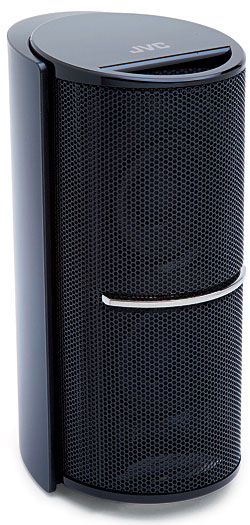 What does JVC mean when it calls the speakers “anisotropic?” The word has several meanings in different branches of science. In this case, JVC uses the term to describe driver diaphragms that have areas of varying density. The company claims that this technique not only reduces resonant colorations, but also expands dispersion at high frequencies. Along with these drivers, the TH-F3 incorporates a proprietary 3D Phonic signal processing in order to provide
an enveloping surround field with all speakers physically in front of the listener. Please note that this system does not just approximate surround from a stereo signal. It contains decoding for Dolby Digital and DTS, so it starts with a true 5.1-channel surround signal. When it does adapt stereo to surround, it uses Dolby Pro Logic II.
What does JVC mean when it calls the speakers “anisotropic?” The word has several meanings in different branches of science. In this case, JVC uses the term to describe driver diaphragms that have areas of varying density. The company claims that this technique not only reduces resonant colorations, but also expands dispersion at high frequencies. Along with these drivers, the TH-F3 incorporates a proprietary 3D Phonic signal processing in order to provide
an enveloping surround field with all speakers physically in front of the listener. Please note that this system does not just approximate surround from a stereo signal. It contains decoding for Dolby Digital and DTS, so it starts with a true 5.1-channel surround signal. When it does adapt stereo to surround, it uses Dolby Pro Logic II.
The subwoofer’s 6.31-inch driver gets a pretty decent 150 watts. That’s specified using the more conservative RMS numbers. It’s not too shabby for a $500 system. The 12-inch cube has a driver on the front, a port in the back, and a glossy black panel on the top. The driver’s cone is aramid—short for aromatic polyamide, a tough, heat-resistant, synthetic fiber. You’d have to look closely to see that the top panel is plastic, not the black lacquer that fancier products use. The cable hard-wires into the sub and terminates—like the other two channels—in a proprietary connector that plugs into the back of the DVD-receiver.
On the back panel, connectivity is limited. Video outputs include HDMI with 1080p upconversion, along with component and composite video. There are no video inputs of any kind, so forget about supplementing this product’s DVD drive with a Blu-ray player or cable box. However, you can plug in an iPod using the supplied iPod dock that plugs into the back. Kudos to JVC for providing this nicety at no extra cost. You can also patch in a USB device using a front-panel input. The JVC also includes two audio inputs—one analog and one digital optical—as well as AM/FM antenna connections. There is also a fan on the back panel to cool the internal components.
Setup is about as simple as it gets. It took me well under a minute to plug in three color-coded speaker and sub cables, plus HDMI-out to my HDTV. I stepped through the menus but didn’t find a single thing that needed changing. My RadioShack SPL meter gathered dust because the menu contains no channel adjustments or test tones. Instead, I used the remote’s dedicated buttons to adjust the surround and subwoofer channel levels—the front channels were fixed. The range of adjustment was narrow. The remote also adjusts the bass and treble.

Subwoofer Commentary
All movie selections were DVDs with Dolby Digital 5.1 soundtracks. The images from the DVD drive were somewhat soft. The Art of War II: Betrayal keeps up a constant commentary on the action via the subwoofer. The succession of low-level bass pulses, psychologically suggestive thuds, and occasional louder effects showed off one of the JVC’s strong suits—its decent sub. A lot of subs that sell for the full price of this system don’t achieve this level of adequacy. A reverb-heavy syncopated drum came through with relatively clean pitch and decay.
- Log in or register to post comments
